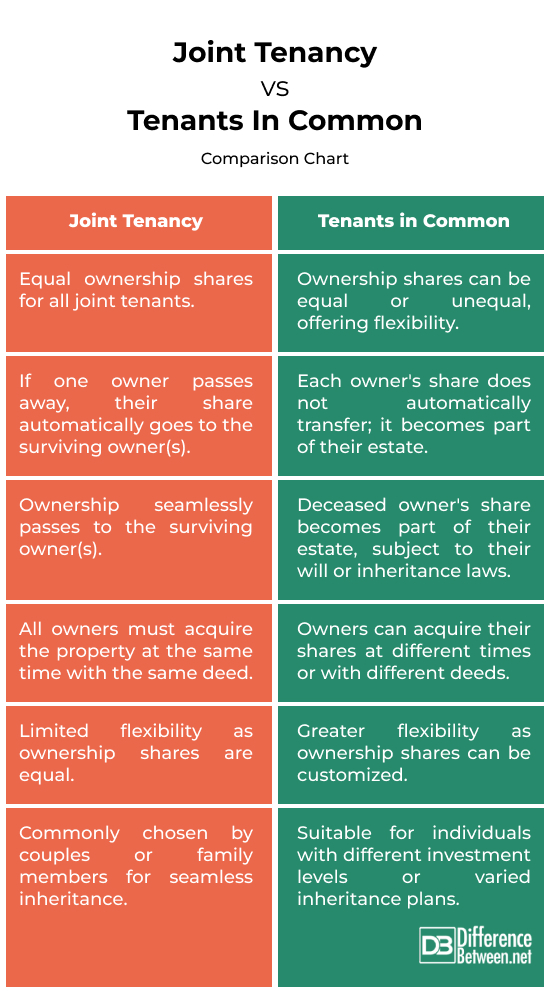Difference Between Joint Tenants and Tenants In Common
When numerous people own a home, it is not uncommon for them to live together in the same residence. There is a stake in the entire property for every individual, regardless of whether they are tenants in common or joint tenants. This indicates that no single individual possesses exclusive ownership of particular components; rather, ownership is distributed across the entirety of the property. Although tenants in common and joint tenancy share some similarities, there are significant distinctions between the two.
Let me explain it to you in more detail!

What is Joint Tenancy?
Joint tenancy is a form of property ownership in which numerous individuals have equal and undivided rights in the entire property. This is analogous to sharing a pizza, in which each person receives an equal slice. Should one of the owners pass away, their portion of the property will be transferred to the surviving owner(s) without the need for any legal procedures or the administration of probate.
In order to ensure a smooth transfer of property in the event of a death, this style of ownership is frequently preferred by couples or members of the same family.

What is Tenancy in Common (TIC)?
Tenancy in common, often known as TIC, is an additional method of co-owning property in which individuals possess a piece of the property, but these shares may not be equal to one another. In contrast to shared tenancy, there is no right of survivorship that is automatically granted. In the event of their passing, each owner has the ability to determine who will inherit their portion of the property, which is often detailed in their will.
Imagine that you are throwing a pizza party where each person gets their own slice, and the slices can be of varying sizes. After the death of one owner, that owner’s share does not instantly pass on to the other owners; rather, it becomes a part of the owner’s estate and is distributed in accordance with the owner’s will or the laws of the local jurisdiction.
Difference between Joint Tenancy and Tenants in Common
Ownership Rights
In joint tenancy, everyone owns an equal share—like sharing a pizza where each person gets the same-sized slice. But in tenants in common, ownership shares can be different. Each person might own a certain percentage of the property, giving more flexibility.
Right of Survivorship
In joint tenancy, there is a right of survivorship. If one owner passes away, their share automatically transfers to the surviving owner(s). Tenancy in common, on the contrary, does not have a right of survivorship. If one owner dies, their share becomes part of their estate and is inherited by their heirs according to their will or local inheritance laws.
Inheritance and Transfer
In the case of joint tenancy, the property ownership smoothly transfers to the surviving owner(s) without going through probate. In tenancy in common, the deceased owner’s share does not automatically transfer; instead, it becomes part of their estate and is subject to the terms of their will or inheritance laws.
Decision-Making Authority
In joint tenancy, decision-making and control are typically shared equally among joint tenants. Each owner has an equal say in matters related to the property. In tenants in common, decision-making and control may not be equal, as ownership percentages can vary. Larger ownership shares may have more influence in decision-making.
Joint Tenancy vs. Tenants in Common: Comparison Chart

Summary
In simple terms, joint tenancy is like a smooth transition of ownership when someone passes away. On the other hand, tenants in common offer more flexibility in ownership shares, and each person’s share becomes part of their estate if they’re no longer around. Understanding these differences is crucial for those thinking about co-ownership, helping them pick the arrangement that suits their preferences and goals.
FAQs
What is better, joint tenancy or tenants in common?
Joint tenancy is often preferred for its seamless transfer of ownership upon death and is suitable for couples or family members. On the other hand, tenants in common provide more flexibility in ownership percentages and inheritance plans.
What are the disadvantages of tenants in common in Ontario?
In Ontario, tenants in common may face challenges related to the lack of a right of survivorship. This means that the transfer of ownership isn’t automatic upon death, potentially leading to complexities in the distribution of the deceased owner’s share.
What is the best tenancy for a married couple?
For a married couple, joint tenancy is often preferred due to its simplicity and the automatic transfer of ownership to the surviving spouse.
What do tenants in common mean in Ontario?
In Ontario, tenants in common refers to co-ownership where individuals hold unequal or equal shares in a property. Unlike joint tenancy, there is no automatic right of survivorship.
What is the difference between joint tenancy and tenants in common in Canada?
Joint tenancy includes an automatic transfer of ownership to surviving owners, while tenants in common lack this feature, allowing for more customized ownership percentages and inheritance arrangements.
Do joint tenants pay capital gains tax?
Joint tenants are generally exempt from capital gains tax when one owner passes away.
What happens to the principal residence at death in Canada?
When an individual passes away, their principal residence is considered to be disposed of at fair market value. However, the tax on any capital gains may be deferred until the property is eventually sold by the deceased’s estate or heirs.
How to avoid paying capital gains tax on inherited property in Canada?
To do that, heirs may consider designating the property as their principal residence, using the principal residence exemption. Seek professional advice to learn more about it in details.
What is a tenancy in common estate for a deceased person?
A tenancy in common estate for a deceased person refers to the ownership structure where the deceased held a share in a property with others. In this scenario, the deceased’s share becomes part of their estate and is distributed according to their will or local inheritance laws.
- Difference Between Caucus and Primary - June 18, 2024
- Difference Between PPO and POS - May 30, 2024
- Difference Between RFID and NFC - May 28, 2024
Search DifferenceBetween.net :
Leave a Response
References :
[0]Image credit: https://www.canva.com/photos/MAEJPYWmjdk-apartment-tenants/
[1]Image credit: https://www.canva.com/photos/MADPr7MnDZg-tenant-agreement/
[2]Burris, Rachel. “Joint Tenancy: Definition, Pros And Cons.” Rocket Mortgage, 13 July 2023, www.rocketmortgage.com/learn/joint-tenancy.
[3]Chism, Patrick. “Tenancy In Common, Explained.” Rocket Mortgage, 22 Feb. 2023, www.rocketmortgage.com/learn/tenancy-in-common.
[4]McCall, Melissa. “What's the Difference Between Joint Tenancy and Tenancy in Common?” FindLaw, 12 Sept. 2023, www.findlaw.com/realestate/buying-a-home/difference-between-joint-tenancy-and-tenancy-in-common.html.
[5]Chen, James. “Tenancy In Common (TIC) Explained: How It Works and Compared to Joint Tenancy.” Investopedia, 22 Dec. 2023, www.investopedia.com/terms/t/tenancy_in_common.asp.
